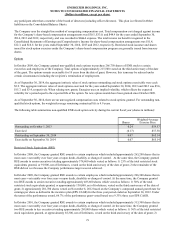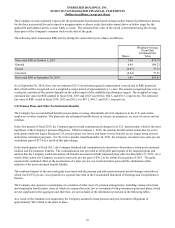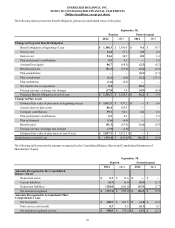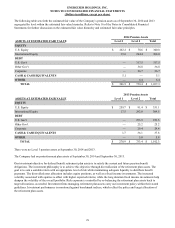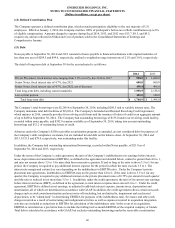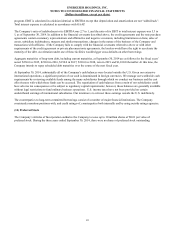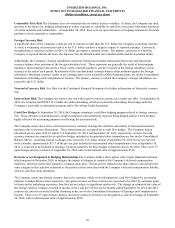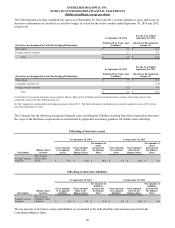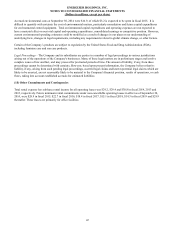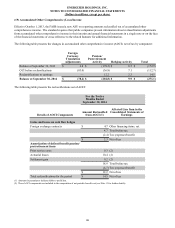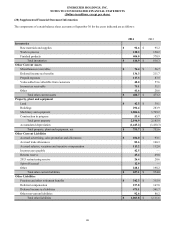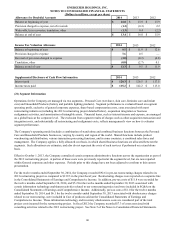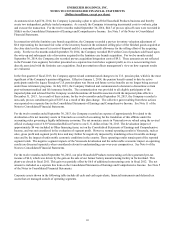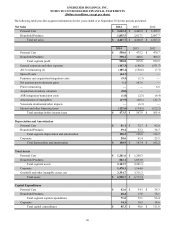Energizer 2014 Annual Report Download - page 87
Download and view the complete annual report
Please find page 87 of the 2014 Energizer annual report below. You can navigate through the pages in the report by either clicking on the pages listed below, or by using the keyword search tool below to find specific information within the annual report.
ENERGIZER HOLDINGS, INC.
NOTES TO CONSOLIDATED FINANCIAL STATEMENTS
(Dollars in millions, except per share)
Commodity Price Risk The Company uses raw materials that are subject to price volatility. At times, the Company has used,
and may in the future use, hedging instruments to reduce exposure to variability in cash flows associated with future purchases
of certain materials and commodities. At September 30, 2014, there were no open derivative or hedging instruments for future
purchases of raw materials or commodities.
Foreign Currency Risk
A significant share of the Company’s sales are tied to currencies other than the U.S. dollar, the Company’s reporting currency.
As such, a weakening of currencies relative to the U.S. dollar can have a negative impact to reported earnings. Conversely,
strengthening of currencies relative to the U.S. dollar can improve reported results. The primary currencies to which the
Company is exposed include the Euro, the Japanese Yen, the British pound, the Canadian dollar and the Australian dollar.
Additionally, the Company’s foreign subsidiaries enter into internal and external transactions that create non-functional
currency balance sheet positions at the foreign subsidiary level. These exposures are generally the result of intercompany
purchases, intercompany loans and to a lesser extent, external purchases, and are revalued in the foreign subsidiary’s local
currency at the end of each period. Revaluation of the non-functional currency balance sheet positions against the foreign
subsidiary’s functional currency results in an exchange gain or loss recorded in Other financing items, net on the Consolidated
Statements of Earnings and Comprehensive Income. The primary currency to which the Company’s foreign subsidiaries are
exposed is the U.S. dollar.
Venezuela Currency Risk See Note 6 to the Condensed Financial Statements for further information on Venezuela currency
risk.
Interest Rate Risk The Company has interest rate risk with respect to interest expense on variable rate debt. At September 30,
2014, the Company had $289.5 of variable rate debt outstanding, which was primarily outstanding borrowings under the
Company's receivable securitization program and its Revolving Credit Agreement.
Cash Flow Hedges At September 30, 2014, the Company maintains a cash flow hedging program related to foreign currency
risk. These derivative instruments have a high correlation to the underlying exposure being hedged and have been deemed
highly effective for accounting purposes in offsetting the associated risk.
The Company enters into a series of forward currency contracts to hedge the cash flow uncertainty of forecasted inventory
purchases due to currency fluctuations. These transactions are accounted for as cash flow hedges. The Company had an
unrealized pre-tax gain of $14.5 and $1.5 at September 30, 2014 and September 30, 2013, respectively, on these forward
currency contracts accounted for as cash flow hedges included in Accumulated other comprehensive loss on the Consolidated
Balance Sheets. Assuming foreign exchange rates versus the U.S. dollar remain at September 30, 2014 levels over the next
twelve months, approximately $13.7 of the pre-tax gain included in Accumulated other comprehensive loss at September 30,
2014, is expected to be included in earnings. Contract maturities for these hedges extend into fiscal year 2016. There were 79
open foreign currency contracts at September 30, 2014 with a total notional value of approximately $316.
Derivatives not Designated in Hedging Relationships The Company holds a share option with a major financial institution,
which matured in November 2014, to mitigate the impact of changes in certain of the Company’s deferred compensation
liabilities, which are tied to the Company’s common stock price. Period activity related to the share option is classified in the
same category in the cash flow statement as the period activity associated with the Company’s deferred compensation liability,
which is cash flow from operations.
The Company enters into foreign currency derivative contracts which are not designated as cash flow hedges for accounting
purposes to hedge balance sheet exposures. Any gains or losses on these contracts are expected to be offset by exchange gains
or losses on the underlying exposures, thus they are not subject to significant market risk. The change in estimated fair value of
the foreign currency contracts resulted in income of $4.2 and $4.9 for the twelve months ended September 30, 2014 and 2013,
respectively, and was recorded in Other financing items, net on the Consolidated Statements of Earnings and Comprehensive
Income. There were 13 open foreign currency derivative contracts which are not designated as cash flow hedges at September
30, 2014, with a total notional value of approximately $270.
83


